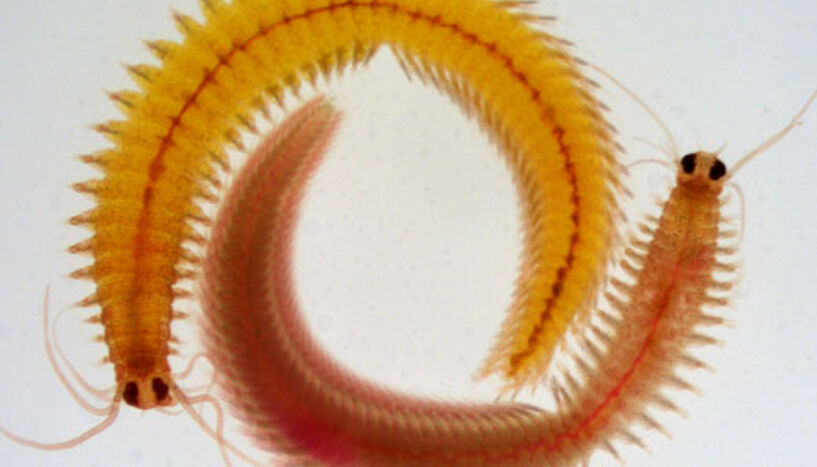Chronobiology: Not everything revolves around the sun
27. September 2013Researchers in Vienna shed light on the interplay of a worm’s inner clocks
For a long time, molecular chronobiology has almost exclusively focused on circadian rhythms that are driven by the changes of day and night and hence follow the daily cycle of the sun. However, especially in the sea, the cradle of evolution, organisms set their pace also according to the moon. Kristin Tessmar-Raible and her team at the Max F. Perutz Laboratories (MFPL) of the University of Vienna and the Medical University of Vienna now show that separate inner clocks, one for the day (set by the sun) and one for the month (set by the moon) exist. They also provide first insight how such inner clocks interact. Their findings are published in the recent edition of the journal "Cell Report".
Reports that the time of reproduction of certain marine animals correlates with the lunar phases go back as far as ancient times. However, the mechanisms of these so-called circalunar rhythms are not understood. Even rather basic questions are still open, such as: Is the circalunar clock molecularly independent of the well-known daily (circadian) clock? How many inner clocks exist in such animals? And if there are independent clocks – would they interact? Using the marine worm Platynereis dumerilii as a model organism, the scientific team of Kristin Tessmar-Raible now describes the worm’s circadian as well as its circalunar clocks and interactions between the two.
Successful reproduction needs precise timing
The worms, which are about three centimeters long and live on the bottom of coastal areas, use the lunar phases to time their maturation and to determine when it is time to swim to the water surface. There they perform a mating dance and release their sperm and egg cells into the water in a timely manner that ensures successful reproduction. This phenomenon of synchronized mating is common among a plethora of other marine organisms, such as evidenced by the mass spawnings of the corals and sea cucumbers of the Great Barrier Reef or the mass mating migration of the Red Crabs of the Christmas Island.
More than one body clock
By first working out the worm’s conventional circadian clock and subsequently blocking its function, the MFPL scientists could now show that Platynereis indeed possess at least two independent clocks, a circadian and a circalunar clock. However, despite being independent, these clocks interact on the level of gene regulation as well as on the level of behavioral control. The latter was clarified thanks to technical help by Andrew Straw of the Institute of Molecular Pathology (IMP).
How the circalunar and the circadian clock interact
More specifically, the results suggest that the circadian clock’s behavioral output is regulated by the circalunar clock: The worms are typically active during the night and much less active during the day. But at times when there would be full moon, even though the worms do not see the additional nocturnal light, they become more active during the day. One may want to call them "diambulistic".
"This reminds a bit of recent work by Swiss scientists showing that the lunar phase has an impact on the human sleep cycle – just reversing day and night", says Juliane Zantke, first author and PhD-student in Kristin Tessmar-Raible’s lab, with a smile. She is referring to the following publication: Curr Biol. 2013 Aug 5;23(15):1485-8. doi: 10.1016/j.cub.2013.06.029: "An exciting question that therefore starts to emerge is, if such multiple clocks might exist in land animals or possibly even in humans."
"I think the way to go is to first understand the cell types and molecules involved in the circalunar clock in organisms for which such clocks are clearly documented and that are molecularly accessible", adds Kristin Tessmar-Raible. "Then we can look if they are conserved in other species."
Kristin Tessmar-Raible and her team are already well on the way to answer these questions in the future.
Original publication in Cell Reports:
Circadian and Circalunar Clock Interactions in a Marine Annelid. Juliane Zantke, Tomoko Ishikawa-Fujiwara, Enrique Arboleda, Claudia Lohs, Katharina Schipany, Natalia Hallay, Andrew D. Straw, Takeshi Todo, and Kristin Tessmar-Raible. September 26, 2013.
DOI: http://dx.doi.org/10.1016/j.celrep.2013.08.031
Scientific contact
Dr. Kristin Tessmar-Raible
Max F. Perutz Laboratories (MFPL) and
Research Platform Marine Rhythms of Life
University of Vienna
T +43-1-4277-746 35
kristin.tessmar(at)mfpl.ac.at
Press contact
Dr. Lilly Sommer
Max F. Perutz Laboratories
Communications
T +43-1-4277-24014
lilly.sommer(at)mfpl.ac.at
Wissenschaftlicher Kontakt
Dr. Kristin Tessmar-Raible
Department für Mikrobiologie, Immunbiologie und Genetik - Max Perutz LabsUniversität Wien
1030 - Wien, Dr. Bohr-Gasse 9
+43-1-4277-746 35
+43-664-602 77-746 35
kristin.tessmar-raible@univie.ac.at
Rückfragehinweis
Dr. Lilly Sommer
Max F. Perutz Laboratories, CommunicationsUniversität Wien
1030 - Wien, Dr.-Bohr-Gasse 9
+43-1-4277-240 14
lilly.sommer@univie.ac.at
Downloads:
Reife_Wuermer_02.jpg
Dateigröße: 1,51 MB
Zantke-li_Tessmar-re_02.jpg
Dateigröße: 897,81 KB


